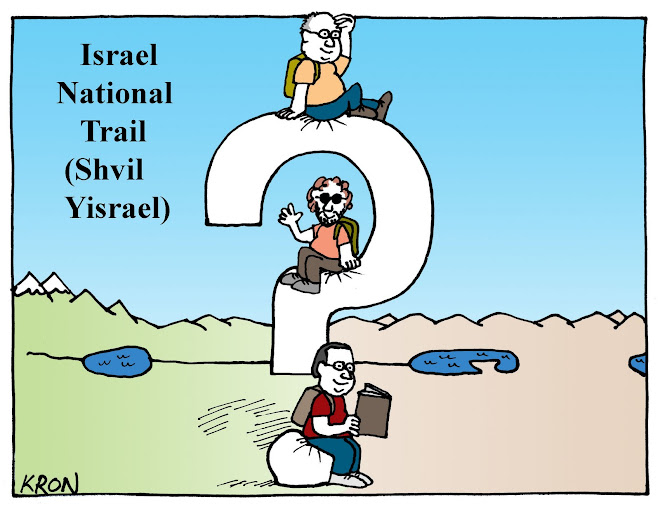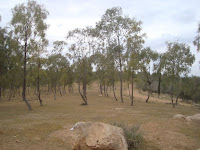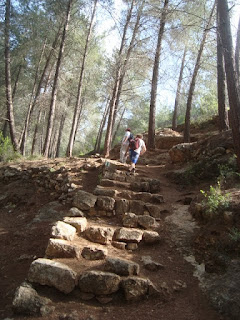We agree every time that it's ridiculous driving 2-3 hours before our shoes see any trail, and every time we set a new record of how much time we waste getting onto the trail, swearing that this is the last time we do it this way. Unfortunately, life constantly gets in the way of our shvil plans. So after leaving home at 5.45, dropping Yoni's daughter Lior off at her air-force base, we hit the shvil at 10 a.m. 10 a.m!!!
We occasionally crib a few hundred metres where possible, since at the end of 20 km, a 500 metre saving is very attractive. However, if cribbing 500 metres means parking your car in a location that is remote enough to allow local car thieves to practise their trade, then parking at the designated start, opposite an army base and forest study centre, seems a far better option. Much of today's walk would be through planted pine forest and the start set the tone. Unfortunately we had unwanted companions in the form of 3 very vicious dogs.
These dogs belonged to the Bedouin shepherd and part time car thief who was tending his flock not far from the path we were walking on. He was obviously angry that we'd parked in a place where he couldn't further his part time career and thus set his dogs upon us. Whilst thankfully we weren't actually bitten, having 3 large, mangy dogs barking and snarling furiously and nipping at your heels is not a great way to start the day's walk. Eventually they lost interest and this proved to be today's only drama. Even Mr. Shvil Painter was well behaved, the markings being plentiful and freshly painted. We didn't have to backtrack even once the whole day. Quite an achievement!
The walking was very peaceful, sometimes in the pine forest, sometimes in the open. I would have thought that even though these pine forests are planted by the J.N.F.,some effort could have been made to make it look natural. This isn't the case however. The Yatir forest consists of perfectly straight rows of planted pine, resembling Elton John's first hair transplant. A random, more natural look would have been more convincing in both cases.
We left the forest and walked through a small nameless valley, passing a Bedouin encampment. Here in the Negev we've driven past Bedouin settlements of Hura, Rahat, Lahia and quite a few tin sheds that pass as encampments. There are Bedouin settlements in the north but it's a different feel. Perhaps it's the sandy desert, or the run-down look, but here in the Negev it's like a different Israel altogether. An Israel that resembles Soweto more than a modern western country.
We passed the Bedouin tin shed, climbed a hill past the Yatir Byzantine ruins and reached the top, where we were met by a platoon of young IDF soldiers, standing in threes, waiting for an exercise or drill to start. This is the first time in close to 500 km of shvil that we'd seen soldiers in manoeuvres. We were surprised to bump into them here, but in retrospect, it's surprising that we hadn't previously encountered other army battalions in training exercises. In any case, Yoni and Garry reminisced about their days of serving the homeland. I had little to add, my 30 days of national service and subsequent stints of guard duty in the reserves having very little affect on the annals of Israel's military history.
There were some slightly more common groups that we encountered en-route. Two groups of through shvillers, one being the "standard" two boys and a girl and another, a pair of older walkers. We don't see many walkers older than us on the shvil and if we do, never through shvillers with their entire earthly belongings strapped to their backs. One was short and wizened, the other tall, thin and rangy. A sort of septuagenarian Tortoise and the Hare. Garry warned that if we didn't get a move on, we'd look like that by the time we reach Eilat. And I don't think he meant it in a positive way. Other common shvill sights included a large group of moto-cross riders, kicking up a dust storm as they drove past. A large group of very serious 4*4 off roaders were having morning tea in a valley we passed through. These vehicles weren't your average soft-road AWD's that might get get you through a mud patch. They all had winches on the front, all sorts of equipment that would help them circumnavigate the moon and looked as if they were preparing to cross the Kalahari. If I was to buy an off road vehicle, it would be one of these heavy-duty ones. Even though I prefer to walk the outdoors, not drive it, doing some real, hard, off-road stuff would be fun.
As we passed trig point 492 and climbed yet another hill, we saw below us a high wire-mesh fence. Between the fence and the adjacent road was a broad sand strip. It looked like a border between enemy states, lets say between Israel and Lebanon, or perhaps an area meant to keep foreigners out, between the US.A and Mexico, for example. It was indeed a border, between Israel proper and the occupied West Bank. It didn't resemble in any way the border of 2 municipalities within Israel, rather It gave the impression that you were about to go into a different country altogether. Hard to see the logic that both sides of a fence like that are part of one country.
We started the day at 650 metres above sea level and walked for a fair bit of time going up and down hills more or less at that height. The last few walks in this area leading to this point have been through semi-desert, green with abundant winter rain. As we head further east and south and the season moves from winter to spring, the green gives way to the dry desert yellow. From this height, looking down to the area below, we saw this transformation quite clearly and it reminded us that from here on in this is what we're going to be walking through. At 650 metres, the weather was quite cool and pleasant. Later in the day we would walk at an altitude of close to 900 metres where the feeling was almost alpine. As we dropped down and approached Meitar at just below 400 metres, the temperature was noticeably higher, the air felt a lot heavier and alpine had given way to desert .
As we walked past Meitar we spotted a family flying model planes.Their dog was keeping them company. As we walked past, the dog gave 2 short barks and sniffed us, tail wagging in welcome. Somehow the comparison with the pack of wolves at the beginning reminded us the differences of cultures in such a small area and how we and our friendly little dogs really don't stand a chance in the rough and tumble reality of the middle-east.
Even though we'd started late and a net drop of 250 metres entailed lots of ups and downs, when we reached Meitar we weren't too tired and had made good time in covering 14 km. With the desire to make the most of the fact that in order to walk in this area we have to drive a long way, we decided to go back to the very start of this leg, at Mt. Amasah and walk through to the forest centre where we'd started. In other words, we started the day in the middle of the leg and walked to the end, then double backed to the actual start of the leg and walked to our starting point, which is actually the middle. Confused? That's nothing compared to the absolute bewilderment on the faces of the 2 groups of through shvillers that we'd seen in the first half, as we crossed paths with them a second time. They couldn't understand how you could cross paths with the same walkers twice in one day. They sheepishly looked over their shoulders, being sure it was a "candid camera" stunt. Not to worry. We may have walked the second half first, but in the end we completed the full 22 km route (with a little bit of obligatory cribbing).
Tuval, where my home is, may not exactly be the centre of the universe, but compared to kibbutz Mt Amasah, it's positively New York City. Mt Amasah is at the end of a road, quite literally, in the middle of no-where, that you climb for what seems forever , winding through backlands that looks like they get only one visitor every three weeks. At almost 900 metres above sea level, this area in no way resembles the desert below. The only thing that reminded us that we were in fact in close to the desert was the large herd of camels grazing happily on the top of the mountain. We're always looking for an alternative method of progressing along the shvil. Perhaps next time we'll ride the shvil on camel. Who knows?
This part of the walk was not substantially different from what we'd seen earlier; ups and downs, through and around pine forests. We did so much walking through pine forest today that upon arriving home, rather than the usual complaints that I'm all sweaty and smelly, Susan and Sivan both commented that I smelt really good, of the fresh outdoors, meaning of pine forest (or they thought that I'd sprayed myself with pine scented air freshener in the bathroom in order to mask the odour of stale sweat).
Our next walk is from Mt. Amasah to the town of Arad. Arad itself holds no particular interest, but after Arad we get onto the last 400 km of hard walking through real desert. We spoke about it along the way, voicing our fears of getting into the most difficult parts of the shvil. We pretty much agreed that we're going to have to lose weight,and get fit in order to complete the remainder of the shvil. It will also take a lot of logistic manoeuvring, resolve and mental toughness.
A couple of hours after setting off from Mt. Amasah we got to Yoni's car. Most of this part had been downhill, but for the final 300 metres that had us climb a steep hill in order to arrive to the entrance to the forest research centre. This final climb was as if to remind us that even if we drop 250 metres in altitude, the shvil is still going to serve us up some uphills.
We'd started later than usual and had walked a long way, so we were eager to head back. We'd gotten three quarters of the way home when the need to replenish protein hit us. Just as well that the El-Sultan restaurant in Zarzir serves good hummus and shawarma.





















































































